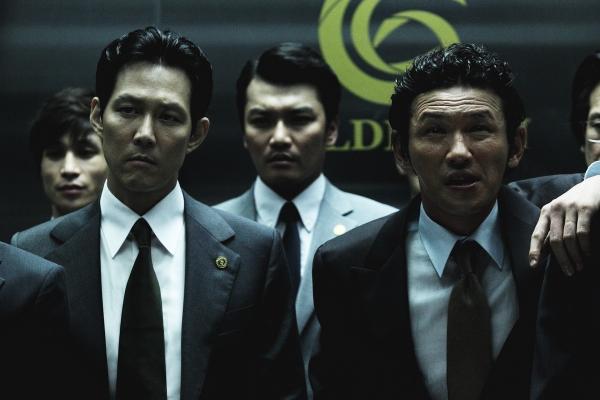Movie review by Greg Carlson
Probably best known in America as the screenwriter of Ji-woon Kim’s terrifying “I Saw the Devil,” Hoon-jung Park closely examines classic and contemporary gangster genre hallmarks in the smart and entertaining “New World.” The Korean filmmaker’s second feature as director, “New World” stylishly blends together key elements of Andrew Lau and Alan Mak’s “Internal Affairs” (and Martin Scorsese’s sinewy, Best Picture-winning American remake “The Departed”) with Johnnie To’s “Drug War.” Most noticeably, the grand gestures and the tragic hero’s journey of “The Godfather,” which Park claims to have studied “dozens of times,” are paid direct and loving tribute.
One of the most common devices in the contemporary thriller is the mole, and Park places undercover cop Ja-sung (Jung-jae Lee) in the eye of the hurricane. Ja-sung’s loyalties and nerve are tested as he rises through the ranks of the octopus-armed Goldmoon front, balancing his commitment to police boss and handler Kang (the shaggy, durable Min-sik Choi) with the constant pressure to impress the board of crime lords monitoring Ja-sung’s devotion to their operation. All the while, Ja-sung’s very life depends on hiding his true identity in a world where skepticism and paranoia are standard procedure. Just as he did in the “I Saw the Devil” script, Park sinks his teeth into the question of whether it takes a monster to catch a monster.
Park studies the minutiae surrounding the procedures for succession when a death leaves a power vacuum in the crime syndicate, and the tight-lipped Ja-sung’s quiet stoicism contrasts with the flamboyance and unpredictability of extrovert Jung Chung (Jung-min Hwang), a deeply dangerous man with whom Ja-sung has spent countless hours and forged an unlikely friendship. The director chooses not to depict Ja-sung’s moral struggle through any of his virtually non-existent after-work relationships. Instead, Park expects the viewer to question Ja-sung’s allegiances along with Kang and Jung Chung, and the tactic builds the necessary level of ambiguity surrounding the question of what “side,” if any, Ja-sung has chosen or will choose.
Another parallel to “I Saw the Devil” materializes in the grisly violence, and although the amount of onscreen mayhem accounts for a smaller total of the running time than the horrors depicted in Kim’s 2010 film, Park stages the shooting, stabbing, and bludgeoning with matter-of-fact calculation that more sensitive viewers will find difficult to stomach (hand-to-hand combat junkies, however, will thrill to a Crazy 88-style parking garage melee that concludes with a nasty, bird’s eye view, elevator knife fight). With its emphasis on sudden death and the posturing of characters defined by competitive machismo, the gangster genre has typically lacked for strong female figures. Park skips the moll entirely, but the movie’s only two significant women are confined to secondary roles, and both are placed in harm’s way.
Several critics have observed that “New World” fails to innovate – or worse, simply recycles the gangster film’s most familiar beats – but an equally compelling argument could be made in favor of the confident way in which Park honors the traditions and conventions of the genre. Additionally, “New World” looks great, from the vivid photography of frequent Chan-wook Park collaborator Chung-hoon Chung to the elegant costume design of Sang-kyung Cho. The smartly tailored suits worn by the gangsters will leave the fashion-conscious out of breath, especially when those handsome outfits get spattered with blood.
